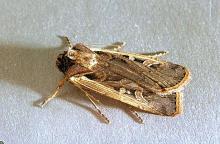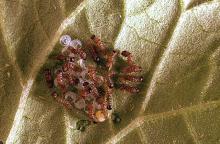Loxagrotis albicosta
Pest description, crop damage and life history
See:
Common Pests of Vegetable Crops
Pest monitoring Apply any of the recommended pesticides as allowed per label 10 to 20 days after the peak moth flight.
Management-cultural control
Weed control is important. Lambsquarters and wild mustard attract egg-laying females and provide a source of food for larvae. Fall tillage can help destroy overwintering pupae.
Home gardeners: Control weeds, grasses, and debris in the vegetable garden that provide cover; hand-pick cutworm larvae, using a flashlight to find them as they are nocturnal, if practical. Scratch the soil at the base of plants to find larvae in the daytime.
Management-chemical control: HOME USE
Apply any one of these materials to the soil surface at first sign of cutworm activity. Consult label. Minimum preharvest interval (PHI) varies with crop.
- azadirachtin (neem oil)-Some formulations are OMRI-listed for organic use.
- Bacillus thuringiensis var. kurstaki (Bt)-Some formulations are OMRI-listed for organic use.
- bifenthrin
- carbaryl-To avoid harming bees, do not apply products containing carbaryl to plants in bloom.
- esfenvalerate
- plant essential oils (rosemary, etc.)-Some have demonstrated efficacy against lepidopteran larvae. Some formulations are OMRI-listed for organic use.
- pyrethrins (often combined with other ingredients)-Some formulations are OMRI-listed for organic use.
- spinosad (as a mix with other ingredient)-Some formulations are OMRI-listed for organic use.
- zeta-cypermethrin
Management-chemical control: COMMERCIAL USE
- esfenvalerate (Asana XL) at 0.03 to 0.05 lb ai/A. PHI 21 days. REI 12 hr. Do not exceed 0.2 lb ai/A per year. Do not feed or graze livestock on treated vines.
- lambda-cyhalothrin (Warrior II) at 0.02 to 0.03 lb ai/A. PHI 21 days. REI 24 hr. Do not feed to or graze livestock. Do not exceed 0.12 lb ai/A per year. Do not apply within 25 ft of an aquatic habitat, 150 ft if applied by air. Washington only.




